Electricity I
- If a current of 3A is divided by the following circuit, the current flowing through the 4Ohm resistor is …
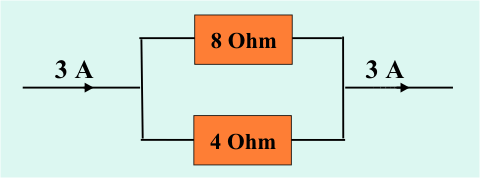
(A) 3 A
(B) 2 A
(C) 1,5 A
(D) 1 ACorrect = B
The electric current splits up according to the resistance (low resistance high current and high resistance low current). If 3A flow into the parallel connection 2/3 of I(2/3of3A=2A) will pass through the 4Ω resistor and 1/3 of I(1/3of3A=1A) through the 8Ω resistor.
- The diagram below shows part of a circuit into which a current I is flowing. Which ammeter shows the highest reading?
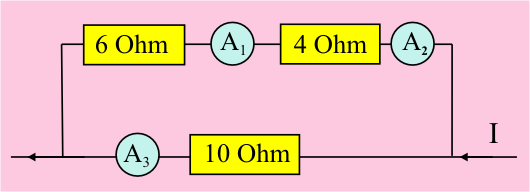
(A) A1
(B) A2
(C) A3
(D) All three ammeters give the same readingCorrect = D
Since the total resistance is the same (2Ω+8Ω=10Ω) in both parts of the parallel connection all ammeters will show the same reading.
- The diagram below represents a part of a circuit containing an ohmic resistor, a voltmeter and an ammeter. If the reading on the ammeter A increases the reading on voltmeter V …
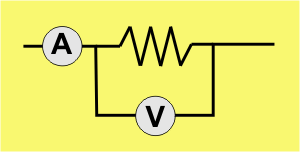
(A) increases in the same ratio.
(B) increases, but not in the same ratio.
(C) remains unchanged.
(D) decreases in the same ratio.Correct = A
Ohm´s Law: the current flowing through a conductor is directly proportional to the potential difference across it provided the temperature of the conductor remains constant. Or in formulae form: R=I/V, to keep R constant I and V have to increase/decrease at the same ratio. - A battery is connected to two identical light bulbs in parallel as well as another identical bulb in series. An ammeter and a voltmeter are also connected as shown in the circuit diagram below.

One of the light bulbs connected in parallel is unscrewed. How will the ammeter and the voltmeter readings change?
Answer Voltmeter Reading Ammeter Reading (A) increases increases (B) increases decreases (C) increases unchanged (D) decreases decreases Correct = B
Unscrewing one of the parallel bulbs will change the total resistance of the circuit in a way that it goes up. Higher resistance will cause a lower current to flow through the circuit (option B and D). How is the p.d. affected? Prior to unscrewing the voltmeter measured the p.d. across one of the bulbs connected in parallel, which had a lower resistance since they were in parallel (1/Rtotal=1/R1+1/R2). After unscrewing a higher voltage is required to drive the current through the bulb » voltmeter reading goes up.
- A learner connects a circuit as shown in the diagram below. They use a source of electricity with an electromotive force (emf) of 12V.
Which one of the following best gives the ammeter and voltmeter readings which the learner is most likely to get with this circuit?
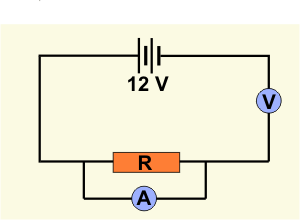
Answer Ammeter reading Voltmeter reading (A) reads zero reads zero (B) reads zero reads 12V (C) very large reading reads zero (D) very large reading reads 12V Correct = B
No current will flow in the circuit due to the position of the voltmeter. Voltmeters have a very high resistance - ammeters on the other hand have a very low resistance - and hence we can say that the resistance of the voltmeter blocks somehow the current. Since the voltmeter is connected across the terminals of the source of electricity it will measure the emf of the battery.
- Three identical resistors of 4Ω are connected to give a combined resistance of 6Ω. Which of the following circuit diagrams illustrates how this was done?
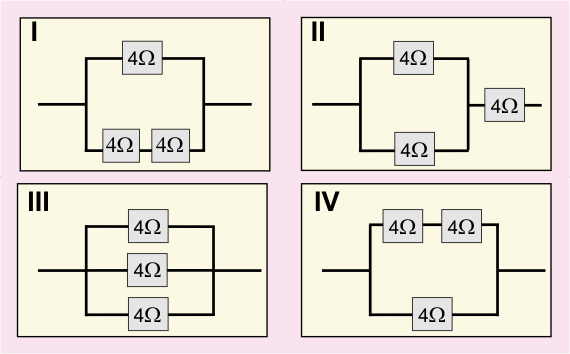
(A) I
(B) II
(C) III
(D) IVCorrect = B
Only in option B the effective resistance is 6Ω:4Ω and 4Ω in parallel - 1/R=1/4+1/4=1/2 hence R=2Ω. 4Ω is in series with 2Ω hence Rcombined=2Ω+4Ω=6Ω.
- In the circuit below B1,B2 and B3 are identical light bulbs. The internal resistance of the battery can be ignored.
Which statement is true regarding the relative brightness of the bulbs?
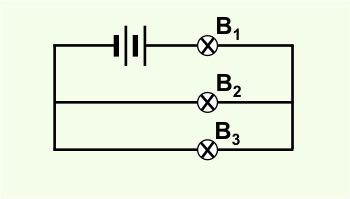
(A) The three bulbs glow with the same brightness.
(B) B2 and B3 glow with the same brightness but brighter than B1.
(C) B2 and B3 glow with the same brightness but less brightly than B1.
(D) B1 glows brighter than B2 while B2 in turn glows brighter than B3.Correct = C
B2 and B3 are connected in parallel, hence only 50% of the current will flow through each of those bulbs and the p.d. across them will be less than the p.d. across B1 (1/3 of total p.d. will be across B2 and B3; 2/3 of total p.d. across B1). As a result B1 will shine brightest (power = current x voltage) and B2 and B3 will have the same brightness.
- Two identical light bulbs, X and Y, are connected in series as shown in the sketch below.
How will the brightness of the bulbs change if switch S is closed?
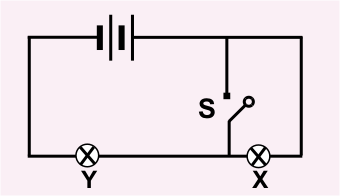
Answer X Y (A) brighter brighter (B) dimmer dimmer (C) brighter not lit up (D) not lit up brighter Correct = D
After closing the switch no current will flow through X, hence it will not lit up (option D) and consequently a hgher current will pass through bulb Y making it shine brighter.
- A student connects three identical resistors as shown in the sketch below.
The potential difference across the battery is 12 Volt. What are the readings on V1 and V2 respectively?
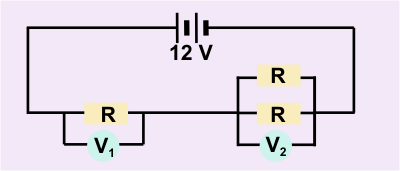
Answer V1 V2 (A) 4 8 (B) 6 6 (C) 8 4 (D) 9 3 Correct = C
Correct answer is option C (see also question 6 & 7): 2/3 of total p.d. will be across single resistor R and 1/3 of total p.d. will be measured across resistors R in parallel by V2⋅2/3⋅12V=8V; and 1/3⋅12V=4V across R in parallel.
- A 9V battery is composed of six 1,5V cells, which are connected in series. Each cell has an internal resistance of 0,2Ω. What is the highest current that can be obtained from such a battery?
(A) 7,5 A
(B) 1,5 A
(C) 1,2 A
(D) 0,3 ACorrect = A
Total internal resistance=6⋅0,2Ω=1,2Ω
Voltage=9VI=V/R=9/1,2=7,5A.








